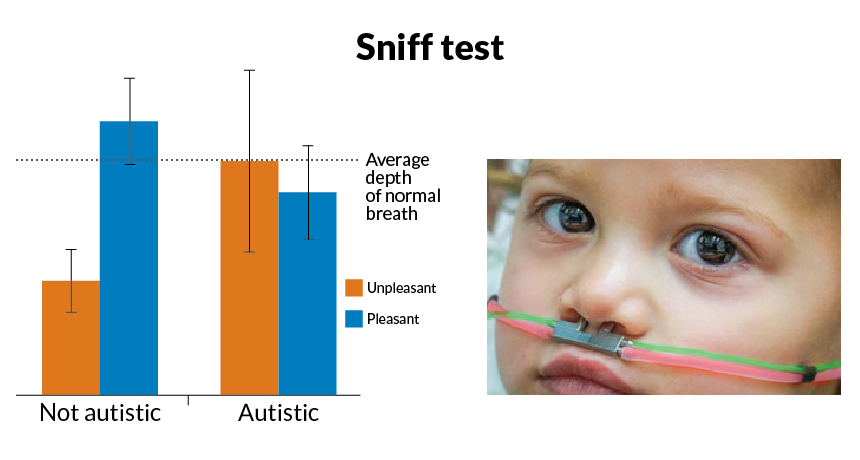Smell test may detect autism
Kids with disorder deeply inhaled foul odors as readily as pleasing scents

Unlike kids without autism, those with the disorder breathe in just about as deeply whether they’re smelling unpleasant odors like sour milk or pleasant ones such as roses, a new study suggests. Researchers delivered scents via tubes hooked up to a child’s nose.
ROZENKRANTZ ET AL/CURRENT BIOLOGY 2015 (GRAPH), OFER PERL (IMAGE)
By Meghan Rosen
A 10-minute test could help doctors sniff out autism, a new study suggests.
Most kids breathe in pleasant scents more deeply than stinky ones. But children with autism inhale about the same amount of air whether smelling roses or sour milk. Researchers reported this July 2 in Current Biology.
The findings hint that a whiff-and-sniff test might one day offer a quick and easy way to determine whether a child has autism. Such tests are already being tried to sniff out risk of dementia in the elderly (because sense of smell diminishes before memory loss in people with Alzheimer’s disease). But keep in mind that the autism study was small. And not all researchers find it convincing.
“It’s a good idea,” says Neil Martin. He is a psychologist at Regent’s University London in England who studies the sense of smell. Still, he says, “You can’t draw any conclusions from this study yet.”
Johannes Frasnelli agrees that the work has a long way to go before it’s ready for clinical use. As a neuroanatomist, he studies the structure of the brain and nervous system at the University of Quebec at Trois-Rivières in Canada. But, Frasnelli says, the study’s authors do have interesting data.Researchers had previously tried to forge a link between autism and the sense of smell. But those results have been all over the map, says study coauthor Liron Rozenkrantz. She works at the Weizmann Institute of Science in Rehovot, Israel. As a neurobiologist, she studies the brain and nervous system.
In many of those earlier tests, instructions were given verbally or in written form. That could be muddling the picture, she contends. Autistic kids might not understand what researchers are asking, Rozenkrantz says. So she and her colleagues sidestepped the problem. They simply hooked up children to an odor-dispensing device. It automatically measures the depth and length of a sniff.
The researchers worked with 18 autistic children and 18 others whose development appeared typical for their age. All were around 7 years old. Over 10 minutes, the researchers delivered 20 odor pulses (shampoo, roses, sour milk or rotten fish) to the nose of each child. Those without autism inhaled good smells more deeply than gross ones. But kids with the disorder didn’t adjust their sniffs.
Rozenkrantz cautions that the test still needs more work. “What we have now is a proof of concept,” she says. “We are very far from claiming we have a diagnostic tool” that would let doctors easily tell who has the disorder.
Martin disagrees. The study didn’t examine nearly enough kids, he says. And the researchers didn’t check whether the children even had a good sense of smell in the first place.
Power Words
(for more about Power Words, click here)
autism (also known as autism spectrum disorders) A set of developmental disorders that interfere with how certain parts of the brain develop. Affected regions of the brain control how people behave, interact and communicate with others and the world around them. Autism disorders can range from very mild to very severe. And even a fairly mild form can limit an individual’s ability to interact socially or communicate effectively.
coauthor One of a group (two or more people) who together had prepared a written work, such as a book, report or research paper. Not all coauthors may have contributed equally.
diagnose To analyze clues or symptoms in the search for their cause. The conclusion usually results in a diagnosis — identification of the causal problem or disease.
nervous system The network of nerve cells and fibers that transmits signals between parts of the body.
neuroanatomy The structure of the brain and nervous system. A person who studies this is a neuroanatomist.
neurobiologist Scientist who studies cells and functions of the brain and other parts of the nervous system.
neuron or nerve cell Any of the impulse-conducting cells that make up the brain, spinal column and nervous system. These specialized cells transmit information to other neurons in the form of electrical signals.
psychology The study of the human mind, especially in relation to actions and behavior. Scientists and mental-health professionals who work in this field are known as psychologists.







